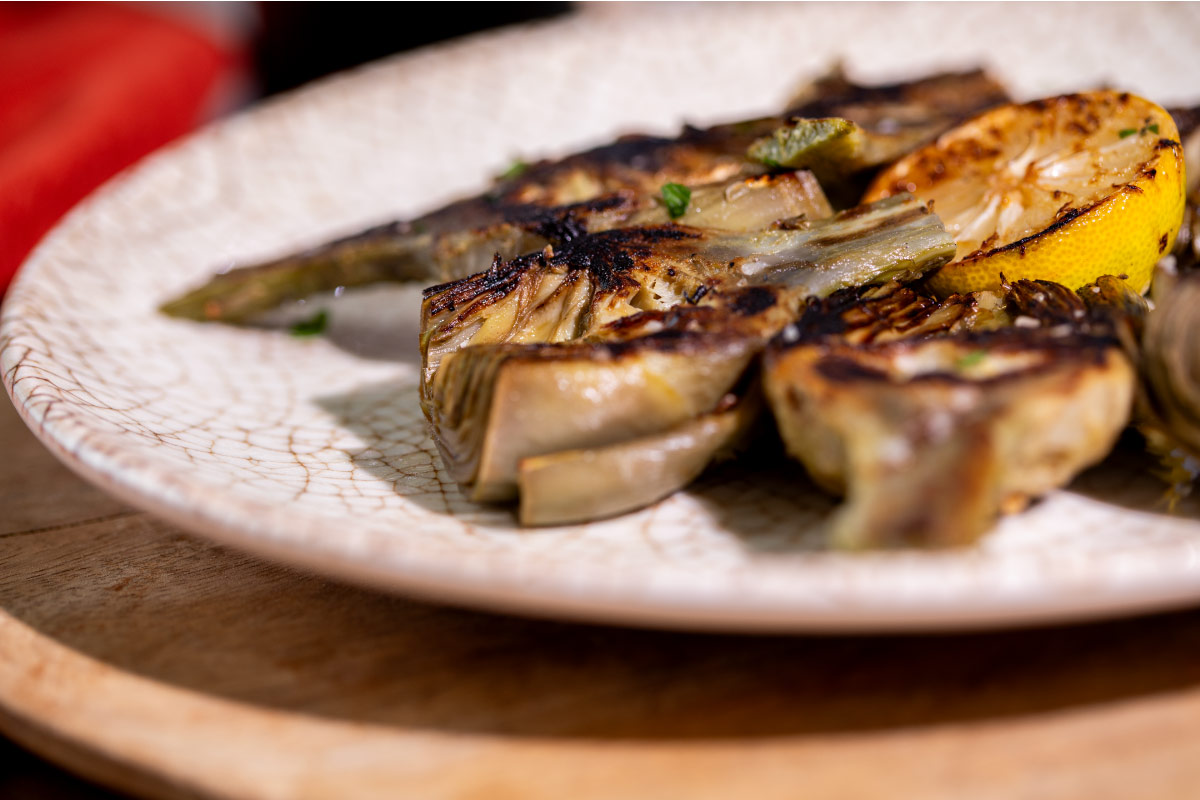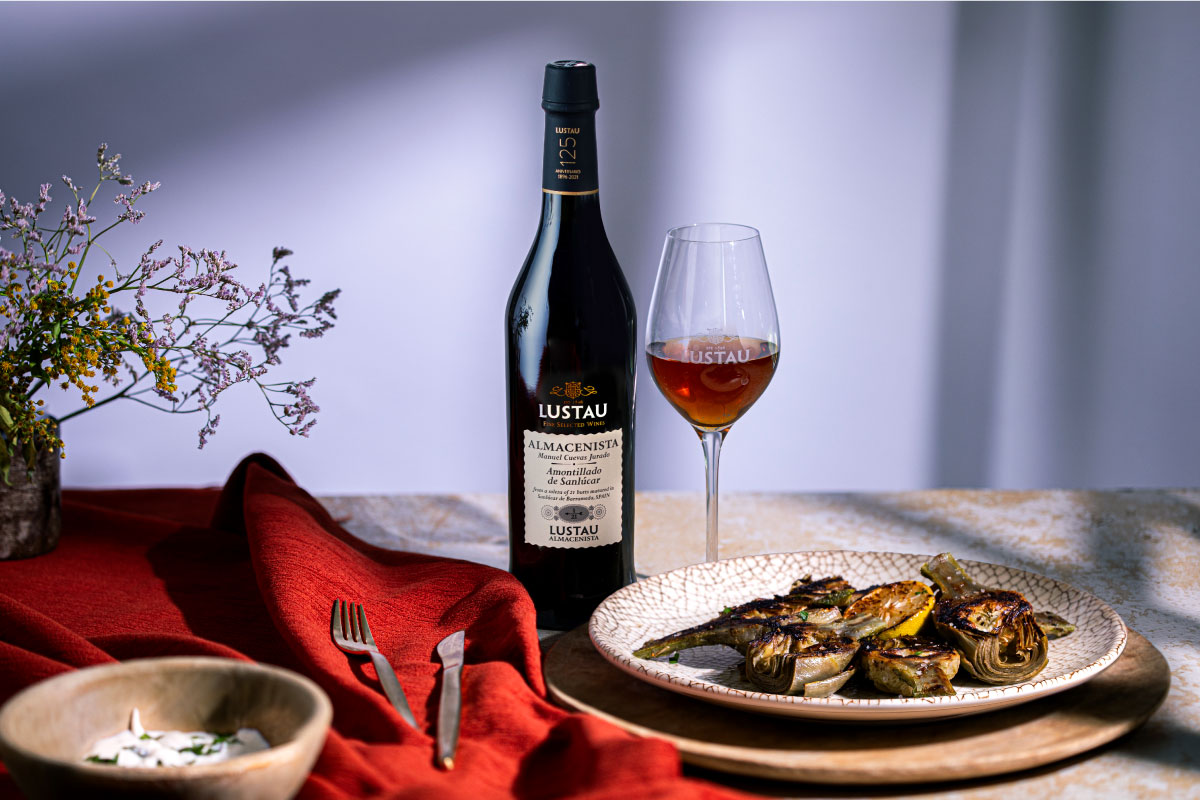Certain compounds, such as capsaicin, isothiocyanates, and piperine, are known for their ability to irritate the trigeminal nerve, triggering a chemosensory reaction in the nose, eyes, and throat. This reaction, often described as a tingling or burning sensation, is commonly associated with foods like onions, chili peppers, radishes, mustard, wasabi, ginger, watercress, arugula, and horseradish. While these intense flavors can dominate the palate and pose a challenge when paired with many wines, sherry rises to the occasion as a formidable match, especially dry oxidative styles.

Rather than being overwhelmed, sherry embraces and enhances the pungency of these foods, providing an aromatic and gustatory depth that balances the harshness. The key to sherry’s success in pairing with complex foods lies in its range of pungent, nutty, salty, and umami-like flavors and its ability to balance bitterness or metallic notes in food. Sherry also tends to have a broader spectrum of flavor intensity, from light and fresh (in fino and manzanilla) to deep and rich (oloroso and amontillado), making it more adaptable.
Even the notoriously tricky artichoke, with its cynarin content that can alter the perception of sweetness and make many wines taste odd, finds its match in the versatile world of sherry. Dry oxidative styles, with their impressive strength and character, skillfully neutralize the artichoke’s challenging components, creating a harmonious experience on the palate. Amontillado sherries, in particular, with their dual aging process, give the wine a unique combination of nuttiness, salinity, and oxidative richness, making it an exceptional partner for certain tricky ingredients. On the palate, the nuttiness, salinity, and slight bitterness of Amontillado harmonize well with the earthy, savory flavors of grilled artichokes. The wine’s oxidation helps balance the potentially clashing elements of the vegetable. In summary, add the pairing to your list if you have not tasted fine amontillado with grilled artichokes!
We found this delicious grilled artichokes with garlic, parsley, and lemon recipe online.
INGREDIENTS
• Lemons: Rub the cut surfaces of the artichokes with lemon juice to prevent them from discoloring as you prepare them. Freshly squeezed lemon juice also gives the marinade its acidic bite.
• Artichokes: There are numerous varieties of artichokes, both big and small. They can also range in color from bright green to purple. You’ll need two large, round “globe” artichokes with the stems attached for this recipe.
• Extra-virgin olive oil: Olive oil carries the aromatic notes of the marinade and keeps the artichokes from drying out on the grill. Use a high-quality extra virgin variety–something robust and peppery like a Spanish Hojiblanca would be particularly delicious with this recipe.
• Kosher salt brings out the fresh garlic and parsley flavor and adds balance.
• Garlic: Finely minced garlic cloves add pungency to the marinade and contrast with the artichokes’ sweet, earthy flavor.
• Red pepper flakes are an easy way to add a bit of heat without overpowering the delicate flavor of the artichokes.
How to Trim Artichokes
• Start with lemon water: Fill a bowl with water and squeeze in the juice of a half lemon. Then add the lemon half to the water. Since artichokes quickly oxidize when exposed to the air, we use lemons two ways to prevent them from turning brown: First, we directly rub the cut surfaces with lemon; second, we immerse them in lemon water.
• Trim the artichokes: Snap off the tough, outer leaves around the stem end along with any blemished leaves; then slice off the top inch of the 2 artichokes. Immediately rub the cut surface with the other half of the lemon. Trim about 1/2-inch off the bottom of the stem and use a vegetable peeler to remove the fibrous outer layer; rub surfaces with lemon. (You can snip off the spiny tips of the outer leaves with kitchen scissors if you like, but I find this unnecessary).
• Quarter and remove the chokes: With a sharp knife, quarter the artichokes lengthwise. Using a paring knife, cut out the hairy choke and prickly purplish leaves in the center to create a cavity. Rub the cut sides with lemon and place the artichoke quarters in lemon water.
How to Make this Grilled Artichoke Recipe
• Steam the artichokes: Place a metal vegetable steamer in a large, wide-mouthed pot and fill it with about an inch of water. Place artichokes in the pan, cover, and bring the water to a boil. Steam the artichokes until the stems and centers can be easily pierced with a paring knife, 12-15 minutes.
• Dress with marinade: While artichokes are steaming, combine 1/2 cup olive oil, 1/2 cup chopped parsley, 2 tablespoons lemon juice, 2 finely chopped garlic cloves, and 1/2 teaspoon red pepper flakes in a measuring cup and season generously with salt to taste. Transfer the steamed artichokes to a baking dish and coat with marinade. Let sit at least an hour, and up to overnight.
• Grill the artichokes: Preheat a gas grill to high. When the grill is hot, grill the artichokes over direct heat until nicely charred, about 5 minutes per side.
• Serve the artichokes: Transfer the grilled artichokes to a large serving dish and sprinkle with salt. Drizzle about a tablespoon of the marinade over the artichokes and pour the rest into small ramekins or bowls for dipping. Serve immediately or let cool and serve at room temperature.








